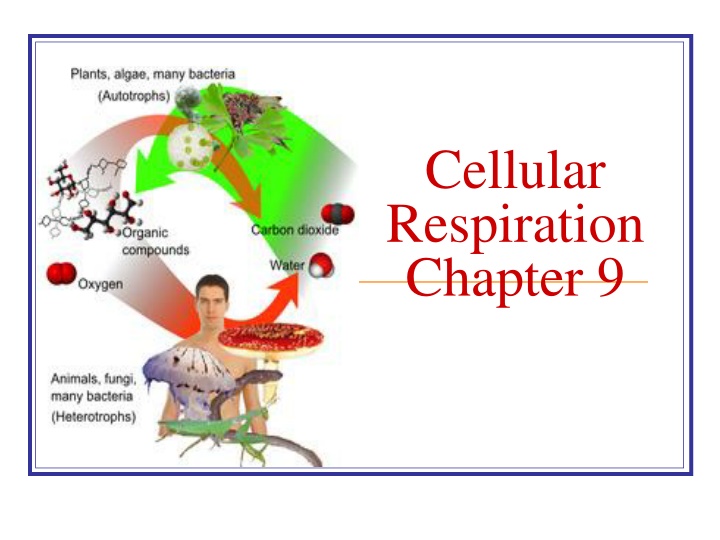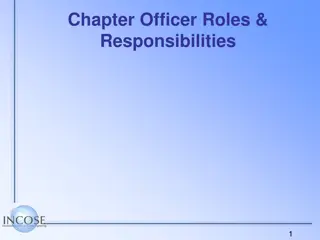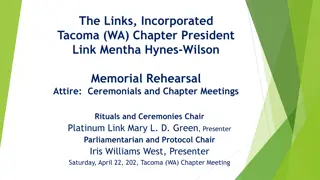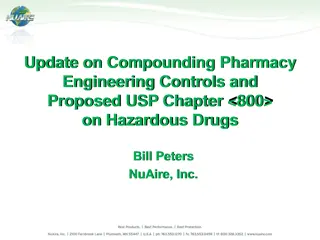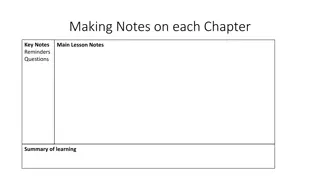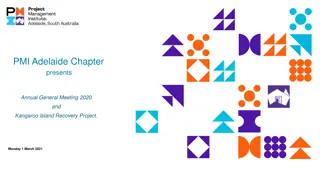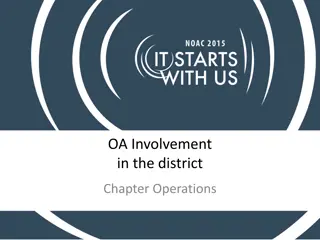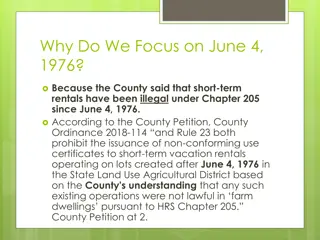Chapter 9
The process of cellular respiration, including aerobic respiration equation, energy review, and the interconnected roles of plants and animals in respiration and photosynthesis. Learn about ATP, glycolysis, Krebs cycle, electron transport chain, and the overall energy production in living organisms.
Download Presentation

Please find below an Image/Link to download the presentation.
The content on the website is provided AS IS for your information and personal use only. It may not be sold, licensed, or shared on other websites without obtaining consent from the author.If you encounter any issues during the download, it is possible that the publisher has removed the file from their server.
You are allowed to download the files provided on this website for personal or commercial use, subject to the condition that they are used lawfully. All files are the property of their respective owners.
The content on the website is provided AS IS for your information and personal use only. It may not be sold, licensed, or shared on other websites without obtaining consent from the author.
E N D
Presentation Transcript
Cellular Respiration Chapter 9
Aerobic Respiration Equation C6H12O6+ 6 O2 6 H2O + 6 CO2 + 36 ATP carbon dioxide oxygen water food (glucose, a carbohydrate)
The BIG Question is Do only animals respire? Or do plants respire too? Only plants perform photosynthesis Plants AND animals perform cellular respiration! (Can you explain why??)
Energy Review Energy Storing Molecules ATP, NADPH (NAD+), FADH (FAD+), FADH2 @ATP supplies most of the energy that drives metabolism in living things@ ATP releases energy when converted into ADP
Cellular Respiration Overview Chapter 9-1 Living things get most of the energy they need from glucose. Autrotrophs make glucose using photosynthesis Heterotrophs get glucose from food they eat Cellular Respiration The process that releases energy by breaking down glucose and other food molecules in the presence of oxygen.
Cellular Respiration Overview Cellular Respiration Overall Equation 6O2 + C6H12O6 6CO2 + 6H2O + Energy Three Stages Glycolysis Kreb s Cycle Electron Transport Chain The Main form of Energy produced = ATP 1. 2. 3.
Figure 92 Cellular Respiration: An Overview Mitochondrion Electrons carried in NADH Electrons carried in NADH and FADH2 Pyruvic acid Glucose Electron Transport Chain Krebs Cycle Glycolysis Mitochondrion Cytoplasm
Glycolysis Glyco = Glucose lysis = Breakdown Occurs in the cytoplasm of the cell @Molecules of GLUCOSE are broken down into 2 molecules of Pyruvic Acid.@ Cell must use (invest) 2 ATP Produces Energy Carrier Molecules 4 ATP 2 NADH
Glycolysis http://highered.mcgraw- hill.com/sites/0072507470/student_view0/c hapter25/animation__how_glycolysis_work s.html Pyruvate = Pyruvic Acid
Glycolysis Glucose Pyruvic Acid Pyruvic Acid To the Electron Transport Chain
The Mighty Mitochondria @The mitochondria is the organelle where the final stages of cellular respiration occurs.@ Kreb s Cycle Electron Transport Chain Cells that use a lot of energy have high numbers of mitochondria. Example: Muscle cells in the heart!!
Krebs Cycle Chapter 9-2 @Aerobic Process =Only if oxygen is present!@ Occurs in the MATRIX of the mitochondria Pyruvic Acid from Glycolysis enters to form 1 ATP 3 NADH 1 FADH2 CO2 (which is released when we exhale!!) AKA .Citric Acid Cycle
Krebs Cycle http://highered.mcgraw- hill.com/sites/0072507470/student_view0/c hapter25/animation__how_the_krebs_cycle _works__quiz_1_.html
Electron Transport Chain Chapter 9-2 Energy carrier molecules produced during Glycolysis and the Kreb s Cycle enter the ETC NADH FADH2 Occurs in the folds of the Inner Membrane of the Mitochondria (Cristae) The electrons are passed down a chain of proteins until they reach the final electron acceptor ..oxygen! So this step is aerobic (requires oxygen) @The ETC produces 32 ATP and H2O@
Electron Transport Chain http://highered.mcgraw- hill.com/sites/0072507470/student_view0/c hapter25/animation__electron_transport_sy stem_and_atp_synthesis__quiz_1_.html The chain then repeats in the same way with FADH2
Section 9-2 Cellular Respiration Flowchart Carbon Dioxide (CO2) + Water (H2O) Glucose (C6H1206) + Oxygen (02) Electron Transport Chain Krebs Cycle Glycolysis
What happens if NO OXYGEN is available?? The Kreb s Cycle and Electron Transport Chain can t function!! These are anaerobic conditions!!
Fermentation The cell can use Fermentation instead!! Occurs in the Cytoplasm Just like glycolysis!! Fermentation A series of reactions that convert NADH (from glycolysis) back into NAD allowing glycolysis to keep producing a small amount of ATP
2 Types of Fermentation Alcoholic Fermentation Yeasts use this process to form ethyl alcohol and carbon dioxide as waste products. This causes bread dough to rise This is how some alcoholic beverages are made Pyruvic Acid + NADH alcohol + CO2 + NAD+
Lactic Acid Fermentation Occurs in bacteria (unicellular organisms) This is how cheese, yogurt, and pickles are made. Occurs in muscles during rapid exercise When your body runs out of oxygen your muscle cells must produce some ATP using fermentation and glycolysis Lactic Acid build-up causes muscle soreness or burning after intense activity. Pyruvic Acid + NADH lactic acid + NAD+
Section 9-1 Chemical Pathways Glucose Krebs cycle Electron transport Glycolysis Alcohol or Lactic Acid Fermentation (without oxygen)
Comparing ATP Production First, your body breaks down glucose through aerobic respiration to produce 36 ATP per glucose molecule; however, this is a slow process. When muscle cells cannot get enough O2 they break down glucose through lactic acid fermentation to produce 2 ATP per glucose @Therefore, AEROBIC RESPIRATION is much more efficient in terms of ATP production @ 36 ATP compared to 2 ATP!
Where is glycolysis performed in the cell and what does it produce? In the cytoplasm 4 ATP 2 NADPH Makes pyruvate (pyruvic acid)
Where does the Krebs cycle occur and does it use oxygen? Matrix of the mitochondria Aerobic process
If no oxygen is present after glycolysis, what process occurs? Is this a more efficient pathway? Fermentation No, aerobic makes 36 ATP whereas anaerobic makes 2ATP.
